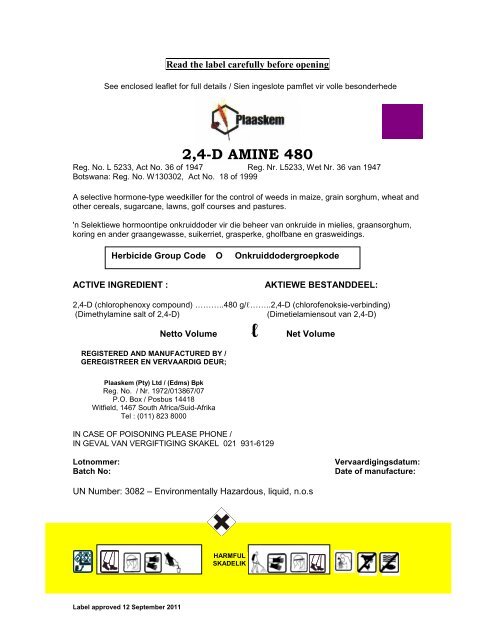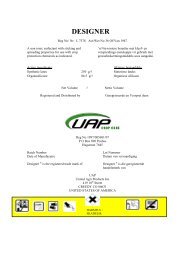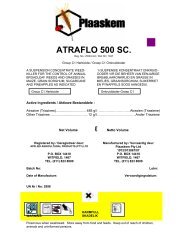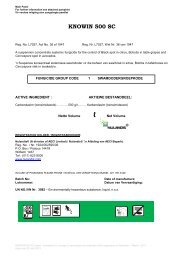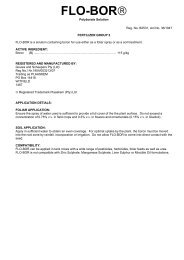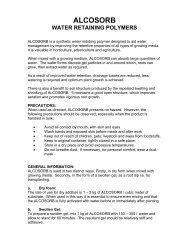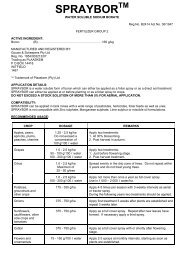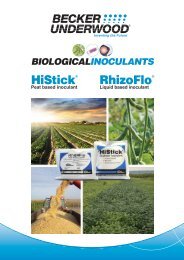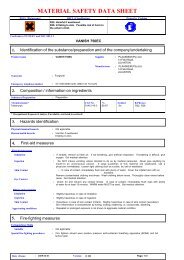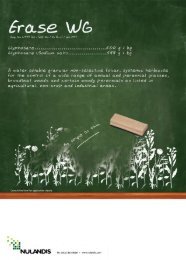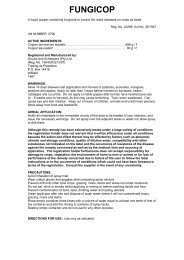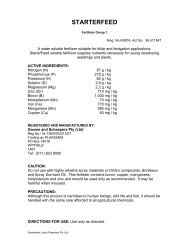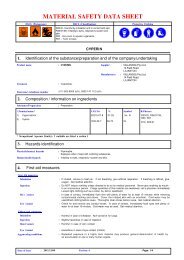You also want an ePaper? Increase the reach of your titles
YUMPU automatically turns print PDFs into web optimized ePapers that Google loves.
Label approved 12 September 2011<br />
Read the label carefully before opening<br />
See enclosed leaflet for full details / Sien ingeslote pamflet vir volle besonderhede<br />
2,4-D AMINE <strong>480</strong><br />
Reg. No. L 5233, Act No. 36 of 1947 Reg. Nr. L5233, Wet Nr. 36 van 1947<br />
Botswana: Reg. No. W130302, Act No. 18 of 1999<br />
A selective hormone-type weedkiller for the control of weeds in maize, grain sorghum, wheat and<br />
other cereals, sugarcane, lawns, golf courses and pastures.<br />
'n Selektiewe hormoontipe onkruiddoder vir die beheer van onkruide in mielies, graansorghum,<br />
koring en ander graangewasse, suikerriet, grasperke, gholfbane en grasweidings.<br />
Herbicide Group Code O Onkruiddodergroepkode<br />
ACTIVE INGREDIENT : AKTIEWE BESTANDDEEL:<br />
2,4-D (chlorophenoxy compound) ………..<strong>480</strong> g/ℓ……..2,4-D (chlorofenoksie-verbinding)<br />
(Dimethylamine salt of 2,4-D) (Dimetielamiensout van 2,4-D)<br />
Netto Volume ℓ Net Volume<br />
REGISTERED AND MANUFACTURED BY /<br />
GEREGISTREER EN VERVAARDIG DEUR;<br />
Plaaskem (Pty) Ltd / (Edms) Bpk<br />
Reg. No. / Nr. 1972/013867/07<br />
P.O. Box / Posbus 14418<br />
Witfield, 1467 South Africa/Suid-Afrika<br />
Tel : (011) 823 8000<br />
IN CASE OF POISONING PLEASE PHONE /<br />
IN GEVAL VAN VERGIFTIGING SKAKEL 021 931-6129<br />
Lotnommer: Vervaardigingsdatum:<br />
Batch No: Date of manufacture:<br />
UN Number: 3082 – Environmentally Hazardous, liquid, n.o.s<br />
HARMFUL<br />
SKADELIK
Pamphlet<br />
Label approved 12 September 2011<br />
2,4-D AMINE <strong>480</strong><br />
Reg. No. L5233 Act. No. 36 of 1947<br />
Botswana: Reg. No. W130302, Act No. 18 of 1999<br />
A selective hormone-type weedkiller for the control of weeds in maize, grain sorghum, wheat and<br />
other cereals, sugarcane, lawns, golf courses and pastures.<br />
ACTIVE INGREDIENT:<br />
2,4-D (chlorophenoxy compound) ………..<strong>480</strong> g/ℓ<br />
(Dimethylamine salt of 2,4-D)<br />
REGISTERED AND MANUFACTURED BY /<br />
GEREGISTREER EN VERVAARDIG DEUR<br />
WARNINGS:<br />
Plaaskem (Pty) Ltd<br />
Reg. No. 1972/013867/07<br />
P.O. Box 14418<br />
Witfield, 1467 South Africa<br />
Tel : (011) 823 8000<br />
Herbicide Group Code O<br />
HARMFUL<br />
DO NOT GRAZE TREATED AREAS WITHIN 7 DAYS AFTER APPLICATION.<br />
Handle with care.<br />
Harmful when absorbed through the skin, swallowed or inhaled.<br />
Toxic to fish and bees.<br />
Keep out of reach of children, uninformed persons and animals.<br />
Store away from food, feed, seed or other agricultural remedies.<br />
Re-entry: Do not enter treated area within 1 day after treatment unless wearing protective<br />
clothing<br />
In case of poisoning – CALL A DOCTOR AND MAKE THIS LABEL AVAILABLE TO HIM.<br />
Aerial application - notify all inhabitants of the immediate area to be sprayed and issue the<br />
necessary warnings. Do not spray over or allow drift to contaminate water or adjacent areas.<br />
ALTHOUGH THIS REMEDY HAS BEEN EXTENSIVELY TESTED UNDER A LARGE<br />
VARIETY OF CONDITIONS THE REGISTRATION HOLDER DOES NOT WARRANT THAT<br />
IT WILL BE EFFICACIOUS UNDER ALL CONDITIONS BECAUSE THE ACTION AND<br />
EFFECT THEREOF MAY BE AFFECTED BY FACTORS SUCH AS ABNORMAL SOIL,<br />
CLIMATIC AND STORAGE CONDITIONS; QUALITY OF DILUTION WATER,<br />
COMPATIBILITY WITH OTHER SUBSTANCES NOT INDICATED ON THE LABEL AND<br />
THE OCCURRENCE OF RESISTANCE OF THE WEEDS AGAINST THE REMEDY<br />
CONCERNED AS WELL AS BY THE METHOD, TIME AND ACCURACY OF<br />
APPLICATION. THE REGISTRATION HOLDER FURTHERMORE DOES NOT ACCEPT<br />
RESPONSIBILITY FOR DAMAGE TO CROPS, VEGETATION, THE ENVIRONMENT OR<br />
HARM TO MAN OR ANIMAL OR FOR LACK OF PERFORMANCE OF THE REMEDY<br />
CONCERNED DUE TO FAILURE OF THE USER TO FOLLOW THE LABEL<br />
INSTRUCTIONS OR TO THE OCCURRENCE OF CONDITIONS WHICH COULD NOT<br />
HAVE BEEN FORESEEN IN TERMS OF THE REGISTRATION. CONSULT THE SUPPLIER<br />
IN THE EVENT OF ANY UNCERTAINTY.
PRECAUTIONS:<br />
Do not inhale the fumes or spray mist.<br />
Wear protective clothing (face shield, rubber gloves and boots) when handling the product.<br />
Wash contaminated clothing after use.<br />
Wash with soap and water after use or skin contact. In case of eye contact, rinse immediately<br />
with running water.<br />
Do not eat, drink or smoke whilst mixing or applying, or before washing hands and face and<br />
changing clothes.<br />
Prevent contamination of food, feeds, drinking water and eating utensils.<br />
Prevent spray drift onto other crops, grazing, rivers, dams and other areas not under treatment.<br />
Clean applicator with a household ammonia solution (1 %) before using it with other material.<br />
Let solution stand for several hours, preferably overnight. Rinse at least twice. This applicator<br />
should not be used for applying chemicals other than herbicides.<br />
Dispose of wash water where it will not contaminate crops, grazing, rivers, dams etc.<br />
When empty, invert the container over the spray tank or mixing tank and allow it to drain for at<br />
least 30 seconds after the flow has slowed down to a drip. Thereafter rinse the container three<br />
times with a volume of water equal to at least one tenth of that of the container and add the<br />
rinsings to the contents of the spray tank. Destroy the container by puncturing and burying or<br />
burning it. Do not use the container for any other purpose.<br />
SYMPTOMS OF POISONING:<br />
Symptoms may include the following; nausea, vomiting, sweating, headaches, muscle soreness,<br />
abdominal pain and loss of co-ordination. It may also include burns of the mouth, throat and<br />
oesophagus.<br />
FIRST AID TREATMENT<br />
INHALATION: If inhaled, remove patient to fresh air. If not breathing, give artificial respiration. If<br />
breathing is difficult, give oxygen. Get medical attention.<br />
INGESTION: DO NOT INDUCE vomiting unless directed to do so by medical personnel. Never<br />
give anything by mouth to an unconscious person. If large quantities of this material are<br />
swallowed, call a physician immediately. Loosen tight clothing such as a collar, tie, belt or<br />
waistband.<br />
SKIN CONTACT: In case of contact, immediately flush skin with plenty of water. Remove<br />
contaminated clothing and shoes. Cold water may be used. Wash clothing before re-use. Get<br />
medical attention.<br />
EYE CONTACT: Check for and remove any contact lenses. In case of contact, immediately<br />
flush eyes with plenty of water for at least 15 minutes. Cold water may be used. Get medical<br />
attention.<br />
NOTE TO PHYSICIAN<br />
No specific treatment – treat symptomatically<br />
Label approved 12 September 2011
USE RESTRICTIONS:<br />
To prevent damage, do not permit drift, vapour or spray mist to come into contact with<br />
sensitive broadleaf crops, fruit or ornamentals. Apply the product strictly in accordance<br />
with the application directions.<br />
THE WIND SPEED AND DIRECTION AT THE TIME OF APPLICATION WILL DETERMINE<br />
THE DISTANCE WHICH MUST SEPARATE THE CLOSEST EDGE OF THE AREA TO BE<br />
SPRAYED FROM SU<strong>SC</strong>EPTIBLE CROPS.<br />
WIND SPEED km/h AERIAL APPLICATION GROUND APPLICATION<br />
1,5 - 5<br />
5 - 10<br />
10 - 15<br />
Label approved 12 September 2011<br />
800 m downwind<br />
800 m crosswind<br />
15 m upwind<br />
1 600 m downwind<br />
800 m crosswind<br />
15 m upwind<br />
3,2 km downwind<br />
800 m crosswind<br />
15 m upwind<br />
200 m downwind<br />
200 m crosswind<br />
6 m upwind<br />
400 m downwind<br />
200 m crosswind<br />
1.5 m upwind<br />
800 m downwind<br />
400 m crosswind<br />
1,5 m upwind<br />
Above 15 Prohibited Prohibited<br />
RESISTANCE WARNING:<br />
For resistance management, 2,4-D <strong>Amine</strong> <strong>480</strong> is a group code O herbicide. Any weed<br />
population may contain individuals naturally resistant to 2,4-D <strong>Amine</strong> <strong>480</strong> and other group code<br />
O herbicides. The resistant individuals can eventually dominate the weed population if these<br />
herbicides are used repeatedly. The resistant weeds may not be controlled by 2,4-D <strong>Amine</strong> <strong>480</strong><br />
or any other group code O herbicides.<br />
To delay herbicide resistance:<br />
• Avoid exclusive repeated use of herbicides from the same herbicide group code.<br />
Alternate or tank mix with registered products from different herbicide group codes.<br />
• Integrate other control methods (chemical, cultural, biological) into weed control<br />
programmes.<br />
For specific information on resistance management contact the registration holder of this product<br />
DIRECTIONS FOR USE: USE ONLY AS DIRECTED<br />
Do not apply to land adjacent to susceptible crops.<br />
May be applied by air, tractor or by hand sprayers on land in the vicinity of susceptible crops,<br />
provided adequate precautionary measures are taken to avoid spray drift.<br />
MIXING INSTRUCTIONS:<br />
2,4-D <strong>Amine</strong> <strong>480</strong> selective weedkiller must be diluted with water and applied as an evenly<br />
distributed fine spray. The exact amount of water to be used will be obtained when not less than<br />
200 l of the mixture per ha is used. Always calibrate the spraying equipment before use in order<br />
to ascertain the exact quantity of fluid delivered per ha.
METHOD OF APPLICATION:<br />
GROUND APPLICATION<br />
Avoid fine droplet size - use low pressure flat fan nozzles of 80° or equivalent anti-drift type, and<br />
do not exceed spray pressure of 200 kPa.<br />
Spray volume must exceed 150 ℓ/ha.<br />
Do not exceed spray height of 50 cm above target and ground speed of 10 km/h.<br />
Do not apply if wind velocity exceeds 15 km/hour (as measured by handheld wind recorder<br />
approved by the Registrar: Act No. 36 of 1947)<br />
The difference between the wet and dry bulb readings on a whirling hygrometer must not exceed<br />
8 °C.<br />
POST-EMERGENCE SPRAYING:<br />
Spraying should only be carried out when the crop is in a suitable stage of development as<br />
indicated below.<br />
For the best results, weeds should be sprayed when in the young stages and growing vigorously.<br />
As they mature the rate of application should be increased accordingly, but the prescribed rates<br />
must not be exceeded. When in flower, most weeds are resistant to normal application. Rainfall<br />
after 12 hours of application will not reduce the effectiveness of the weedkiller.<br />
AERIAL APPLICATION: (Do not apply 2,4-D <strong>Amine</strong> <strong>480</strong> by air in Kwa-Zulu Natal)<br />
Aerial application may only be done by a registered aerial application operator using a correctly<br />
calibrated, registered aircraft according to the instructions of SANS Code 10118 (Aerial<br />
Application of Agricultural Pesticides). It is important to ensure that the spray mixture is<br />
distributed evenly over the target area and that the loss of spray material during application is<br />
restricted to a minimum. It is therefore essential that the following criteria are met:<br />
Equipment:<br />
q Use a conventional boom and nozzles equipped with flat fan tips.<br />
q Apply before the crop becomes too dense, thus preventing proper coverage of the weeds<br />
q The operator must use a setup that will produce a droplet spectrum with the lowest possible<br />
relative span.<br />
q All nozzles / atomisers should be positioned within the inner 60 to 75 % of the wingspan to<br />
prevent droplets from entering the wingtip vortices.<br />
Application parameters:<br />
q A minimum volume of 30 l spray mixture per hectare is recommended. As this product has<br />
not been evaluated at a reduced volume rate, the registration holder cannot guarantee<br />
efficacy, or be held responsible for any adverse effects if this product is applied aerially at a<br />
lower volume rate than recommended above.<br />
q A droplet coverage of 30 - 45 droplets per cm 2 must be recovered at the target.<br />
q A droplet spectrum with a VMD of 350 microns is recommended. Ensure that the production<br />
of fine droplets (smaller than 150 microns) is restricted to a minimum.<br />
q The height of the spray boom should be maintained at 3-4 metres above the target. Do not<br />
spray when aircraft is in a climb, at the top or during a dive, or when banking.<br />
Label approved 12 September 2011
Meteorological conditions:<br />
q The difference between the wet and dry bulb readings as determined by a whirling<br />
hygrometer, must not exceed 8 °C.<br />
q Do not spray under turbulent, unstable conditions during the heat of the day when rising<br />
thermals and downdraughts occur.<br />
q Do not spray under temperature inversion conditions (spraying in or above the inversion<br />
layer).<br />
q Do not spray if the wind speed exceeds 15 km/h.<br />
General:<br />
q Ensure that fields are accurately marked and that the aerial spray operator knows exactly<br />
which fields to spray.<br />
q Obtain an assurance from the aerial spray operator that the above requirements will be met.<br />
APPLICATION TABLE:<br />
CROP<br />
BARLEY AND RYE<br />
LAWNS AND GOLF<br />
COURSES<br />
GRAIN SORGHUM<br />
(post-emergence<br />
only)<br />
GRASS PASTURES<br />
MAIZE<br />
(post-emergence)<br />
After 460 mm<br />
height<br />
SUGARCANE<br />
(post-emergence only)<br />
WHEAT<br />
(post-emergence<br />
only)<br />
Label approved 12 September 2011<br />
DOSAGE RATE<br />
(ℓ/ ha)<br />
REMARKS<br />
1,5 - 2,6 ℓ Apply in the 5 - 7 leaf stage of the crop.<br />
3,3 - 4,4 ℓ<br />
2 ℓ<br />
Apply once the grass has become established. For<br />
lawns repeated applications may be necessary. An<br />
application of nitrogenous fertilizer 2 - 3 weeks<br />
before spraying is recommended.<br />
Apply when plants are 150 mm high or about 3<br />
weeks after emergence of the crop. Spray may be<br />
applied later provided directional spraying using<br />
drop arms is practiced.<br />
3,3 - 4,4 ℓ Apply once grass is growing well. Repeat if<br />
necessary.<br />
2 ℓ<br />
5,25 - 7,25 ℓ<br />
1,35 - 2,7 ℓ<br />
Grasses which have already emerged will not be<br />
controlled.<br />
NB: Drop arms must be used.<br />
The addition of BIODEW (Reg. No. L8120), a<br />
spreader/sticker is recommended. Maize may<br />
become malformed and brittle after application but<br />
this is usually of a temporary nature.<br />
Apply in 300 – 400 ℓ water/ha. If the sugarcane<br />
exceeds a height of 400 mm or has unfurled more<br />
than 5 leaves per shoot, directed spraying must be<br />
carried out or else the growth may be retarded.<br />
Apply between growth stages 7 (centre double<br />
ridges enlarged) and 13 (awn of top spikelets<br />
elongated) according to the list of growth stages of<br />
the ARC Small Grain Institute at Bethlehem.
BROADLEAF WEEDS CONTROLLED:<br />
The following weeds are normally controlled by 2,4-D <strong>Amine</strong> <strong>480</strong> at the dosage rates indicated<br />
above.<br />
Amaranthus deflexus perennial pigweed<br />
Arctotis leiocarpa Karoo daisy<br />
Bidens formosa => Cosmos bipinnatus cosmos<br />
Bidens pilosa blackjack<br />
Chenopodium album white goosefoot<br />
Commelina benghalensis Bengal wandering Jew<br />
Datura stramonium thorn apple<br />
Galinsoga parviflora gallant soldier<br />
Polygonum aviculare prostrate knotweed = hogweed<br />
Raphanus raphanistrum wild radish<br />
Striga asiatica witch weed<br />
Tagetes minuta khaki weed<br />
Tribulus terrestris Devils thorn = Dubbeltjie<br />
Vicia sativa broad-leaved purple vetch<br />
Xanthium strumarium cocklebur<br />
GRASS WEEDS CONTROLLED:<br />
Eleusine indica => Eleusine corocana (pre-emergence) goose grass<br />
Panicum laevifolium => Panicum schinzii (pre-emergence) sweet buffalo grass<br />
BIODEW ® is the registered trademark of Gouws & Scheepers (Pty) Ltd<br />
Label approved 12 September 2011
PAMFLET<br />
Label approved 12 September 2011<br />
2,4-D AMINE <strong>480</strong><br />
Reg. Nr. L 5233 Wet Nr. 36 van 1947<br />
'n Selektiewe hormoontipe onkruiddoder vir die beheer van onkruide in mielies, graansorghum,<br />
koring en ander graangewasse, suikerriet, grasperke, gholfbane en grasweidings.<br />
AKTIEWE BESTANDDEEL:<br />
2,4-D (chlorofenoksie-verbinding) ....................................<strong>480</strong> g/ℓ<br />
(Dimetielamiensout van 2,4-D)<br />
GEREGISTREER EN VERVAARDIG DEUR:<br />
WAARSKUWINGS:<br />
Plaaskem (Edms) Bpk<br />
Reg. Nr. 1972/013867/07<br />
Posbus 14418<br />
Witfield, 1467 Suid-Afrika<br />
Tel : (011) 823 8000<br />
ONKRUIDDODERGROEPKODE O<br />
SKADELIK<br />
MOENIE BINNE 7 DAE NA TOEDIENING LAAT BEWEI NIE<br />
Hanteer versigtig. Giftig indien ingesluk, ingeasem of deur die vel opgeneem word.<br />
Giftig vir visse en bye.<br />
Hou buite die bereik van kinders, oningeligte persone en diere.<br />
Berg weg van voedsel,voer, saad of ander landboumiddels.<br />
Herbetreding: Moenie behandelde gebied betree vir 1 dag na die bespuiting nie, tensy<br />
beskermende oorklere gedra word.<br />
In geval van vergiftiging – ONTBIED ‘N GENEESHEER EN STEL HIERDIE ETIKET AAN HOM<br />
BESKIKBAAR.<br />
Lugtoediening - stel alle persone in die onmiddellike omgewing van die gebied wat behandel<br />
gaan word in kennis en reik die nodige waarskuwings uit. Moenie aangrensende gebiede of<br />
waterbronne bespuit of toelaat dat die sproeinewel daarheen oorwaai nie.<br />
ALHOEWEL HIERDIE MIDDEL OMVATTEND ONDER 'N GROOT VERSKEIDENHEID<br />
TOESTANDE GETOETS IS, WAARBORG DIE REGISTRASIEHOUER NIE DAT DIT ONDER<br />
ALLE TOESTANDE DOELTREFFEND SAL WEES NIE AANGESIEN DIE WERKING EN EFFEK<br />
DAARVAN BEÏNVLOED KAN WORD DEUR FAKTORE SOOS ABNORMALE GROND-,<br />
KLIMAATS- EN BERGINGSTOESTANDE, KWALITEIT VAN VERDUNNINGSWATER,<br />
VERENIGBAARHEID MET ANDER STOWWE WAT NIE OP DIE ETIKET AANGEDUI IS NIE EN<br />
DIE VOORKOMS VAN WEERSTAND VAN ONKRUIDE TEEN DIE BETROKKE MIDDEL SOWEL<br />
AS DIE METODE, TYD EN AKKURAATHEID VAN TOEDIENING. VERDER AANVAAR DIE<br />
REGISTRASIEHOUER NIE VERANTWOORDELIKHEID VIR SKADE AAN GEWASSE,<br />
PLANTEGROEI, DIE OMGEWING OF VIR NADELIGE EFFEK OP MENS OF DIER OF VIR 'N<br />
GEBREK AAN PRESTASIE AS GEVOLG VAN DIE VERSUIM VAN DIE GEBRUIKER OM<br />
ETIKETAANWYSINGS NA TE KOM OF AS GEVOLG VAN DIE ONTSTAAN VAN TOESTANDE<br />
VAN NIE KRAGTENS DIE REGISTRASIE VOORSIEN KON WORD NIE. RAADPLEEG DIE<br />
VERSKAFFER IN DIE GEVAL VAN ENIGE ONSEKERHEID.
VOORSORGMAATREëLS:<br />
Moenie dampe of sproeinewel inasem nie.<br />
Dra beskermende klere (gesigskerm-, stewels en rubberhandskoene) wanneer produk hanteer<br />
word.<br />
Was besoedelde klere na gebruik.<br />
Was met seep en water na gebruik of velkontak. In geval van oogkontak spoel onmiddellik met<br />
lopende water.<br />
Moenie eet, rook of drink tydens vermenging of toediening of voordat hande en gesig gewas en<br />
skoon klere aangetrek is nie.<br />
Verhoed besoedeling van voedsel, voer, drinkwater en eetgerei.<br />
Verhoed wegdrywing van die sproeinewel na ander gewasse, weidings, riviere, damme en ander<br />
gebiede wat nie behandel word nie.<br />
Maak toedieningsapparaat met 'n huishoudelike ammoniakoplossing (1 %) skoon voordat dit met<br />
ander middels gebruik word. Laat staan die oplossing vir 'n paar uur, verkieslik oornag. Spoel ten<br />
minste tweekeer uit. Hierdie spuittoerusting behoort nie gebruik te word vir die toediening van<br />
enige ander landboumiddels, behalwe onkruiddoders nie.<br />
Gooi waswater weg waar dit nie voedsel, weiding, riviere of damme sal besoedel nie<br />
Sodra die houer leeg is keer dit om oor die spuittenk of mengbak en dreineer vir minstens 30<br />
sekondes nadat die vloei tot 'n gedrup verminder het. Spoel die houer daarna driekeer uit met ‘n<br />
volume water gelyk aan minstens ‘n tiende van die houer en gooi die spoelwater by die inhoud<br />
van die spuittenk. Vernietig die houer deur gate daarin te maak en te begrawe of te verbrand.<br />
Moenie die houer vir enige ander doel gebruik nie.<br />
SIMPTOME VAN VERGIFTIGING:<br />
Simptome mag die volgende insluit; naarheid, braking, sweetafskeiding, hoofpyn, spierpyn,<br />
maagpyn en gebrek aan ko-ordinasie. Dit mag ook brandwonde aan die mond, keel en slukderm<br />
veroorsaak.<br />
NOODHULPBEHANDELING:<br />
INASEMING: Indien ingeasem, verwyder pasiënt na vars lug. Indien pasiënt ophou asemhaal,<br />
pas kunsmatige asemhaling toe. Indien asemhaling bemoeilik word, gee suurstof. Verkry<br />
mediese hulp.<br />
INGESLUK: MOENIE braking veroorsaak tensy so aanbeveel deur mediese personeel. Moet<br />
nooit iets per mond aan ‘n bewustelose persoon gee nie. Indien groot hoeveelhede van die<br />
middel gedrink is skakel onmiddellik ‘n geneesheer. Maak styfpassende klere, soos ‘n kraag,<br />
das, belt of lyfband los.<br />
VELKONTAK: Ingeval van velkontak, spoel onmiddellik af met genoegsame water. Verwyder<br />
besoedelde klere en skoene. Koue water mag gebruik word. Was klere na gebruik. Verkry<br />
mediese hulp.<br />
OOGKONTAK: Gaan na en verwyder enige kontaklense. In geval van oogkontak, spoel<br />
onmiddellik met genoegsame water vir minstens 15 minute. Koue water mag gebruik word.<br />
Verkry mediese hulp.<br />
INLIGTING AAN GENEESHEER:<br />
Geen spesifieke behandeling – behandel simptomaties.<br />
Label approved 12 September 2011
GEBRUIKSBEPERKINGS:<br />
Om skade te voorkom moet verhoed word dat dampe of sproeinewel in aanraking kom met<br />
of wegdryf na sensitiewe breëblaargewasse, vrugtebome of sierplante. Dien die produk<br />
streng volgens die gebruiksaanwysings toe.<br />
DIE WINDSPOED EN WINDRIGTING TYDENS TOEDIENING SAL DIE AFSTAND TUSSEN<br />
DIE NAASTE RAND VAN DIE GEBIED WAT BESPUIT MOET WORD EN DIE GEVOELIGE<br />
GEWASSE BEPAAL.<br />
WINDSPOED km/h LUGTOEDIENING GRONDTOEDIENING<br />
1,5 - 5<br />
5 - 10<br />
10 - 15<br />
Label approved 12 September 2011<br />
800 m windaf<br />
800 m dwarswind<br />
15 m windop<br />
1 600 m windaf<br />
800 m dwarswind<br />
15 m windop<br />
3,2 km windaf<br />
800 m dwarswind<br />
15 m windop<br />
Meer as 15 Verbode Verbode<br />
WEERSTANDSWAARSKUWING:<br />
200 m windaf<br />
200 m dwarswind<br />
6 m windop<br />
400 m windaf<br />
200 m dwarswind<br />
1.5 m windop<br />
800 m windaf<br />
400 m dwarswind<br />
1,5 m windop<br />
2,4-D <strong>Amine</strong> <strong>480</strong> is ‘n groepkode O onkruiddoder. Enige populasie van ‘n spesifieke<br />
onkruidspesie mag individue insluit wat ‘n natuurlike weerstand teen 2,4-D <strong>Amine</strong> <strong>480</strong> of enige<br />
ander groepkode O onkruiddoders het. Indien hierdie onkruiddoders herhaaldelik aangewend<br />
word, kan die weerstandbiedende individue uiteindelik die onkruidpopulasie oorheers. Hierdie<br />
weerstandbiedende onkruide sal waarskynlik nie deur 2,4-D <strong>Amine</strong> <strong>480</strong> of enige ander<br />
groepkode O onkruiddoders beheer word nie.<br />
Om weerstand teen onkruiddoders te vertraag:<br />
• Vermy die eksklusiewe herhaaldelike gebruik van onkruiddoders met dieselfde<br />
groepkode. Wissel af met, of gebruik tenkmengsels van produkte in verskillende<br />
onkruiddodergroepkodes.<br />
• Integreer ander beheermaatreels (chemies, verbouing, biologies) in<br />
onkruidbeheerprogramme.<br />
Vir spesifieke inligting oor weerstandsbestuur kontak die registrasiehouer van hierdie produk.<br />
GEBRUIKSAANWYSINGS: GEBRUIK SLEGS SOOS AANGEDUI<br />
Moenie op lande aangrensend aan gevoelige gewasse toedien nie. Kan met 'n vliegtuig, trekker<br />
of handspuite op lande in die nabyheid van gevoelige gewasse toegedien word, mits<br />
genoegsame voorsorgmaatreëls getref word om spuitstofwegdrywing te voorkom.
MENGINSTRUKSIES:<br />
2,4-D <strong>Amine</strong> <strong>480</strong> selektiewe onkruiddoder moet met water verdun word en as 'n eweredige fyn<br />
sproeinewel toegedien word. Presiese hoeveelhede water sal afhang van die spuitapparaat maar<br />
die beste resultate sal verkry word as nie minder as 200 ℓ van die spuitmengsel per ha gebruik<br />
word. Die spuittoestel moet altyd gekalibreer word vóór gebruik om te verseker dat die korrekte<br />
hoeveelheid onkruiddoder per ha toegedien word.<br />
TOEDIENINGSMETODE:<br />
GRONDTOEDIENING:<br />
Vermy fyn druppelgroottes - gebruik laedruk platwaaierspuitpunte van 80° of ekwivalente antiwegdrywing<br />
tipe. Die spuitdruk moenie 200 kPa oorskry nie.<br />
Spuitvolume moet 150 ℓ/ha oorskry.<br />
'n Spuithoogte van 50 cm bokant die teiken en 'n grondspoed van 10 km/h moenie oorskry word<br />
nie.<br />
Indien die windspoed hoër is as 15 km/h (soos bepaal deur 'n handwindmeter goedgekeur deur<br />
die Registrateur: Wet Nr. 36 van 1947) moet die produk nie toegedien word nie.<br />
Die verskil tussen die nat- en droëbollesing, soos met 'n swaaihigrometer bepaal, moenie meer<br />
as 8 °C wees nie.<br />
NA-OPKOMBESPUITING:<br />
Bespuiting moet alleen geskied wanneer die gewas 'n geskikte stadium van ontwikkeling bereik<br />
het, soos hieronder aangedui. Vir die beste resultate moet die onkruide bespuit word wanneer dit<br />
in jongstadiums verkeer en vinnig groei. Namate die onkruide ouer word moet die hoeveelhede<br />
wat toegedien word dienooreenkomstig verhoog word, maar die hoeveelhede wat vir die<br />
verskillende gewasse voorgeskryf word moenie oorskry word nie. Wanneer hulle in blom is, is<br />
die meeste onkruide bestand teen normale toedieningshoeveelhede. Reënval 12 uur na<br />
toediening sal nie die doeltreffendheid van die onkruiddoder verminder nie.<br />
LUGTOEDIENING (Moenie 2,4-D <strong>Amine</strong> <strong>480</strong> uit die lug uit in Kwa-Zulu Natal toedien nie)<br />
Lugtoediening mag slegs deur ‘n geregistreerde lugbespuitingsoperateur met ‘n korrek<br />
gekalibreerde, geregistreerde vliegtuig volgens die instruksies van SANS Kode 10118 (Aerial<br />
Application of Agricultural Pesticides) gedoen word. Dit is belangrik om te verseker dat die<br />
spuitmengsel eweredig oor die teikenarea versprei word en dat die verlies aan spuitmengsel<br />
tydens toediening tot ‘n minimum beperk word. Dit is dus belangrik om aan die volgende kriteria<br />
te voldoen:<br />
Toerusting:<br />
q Gebruik ‘n konvensionele spuitbalk waarvan die spuitstukke met platwaaierspuitpunte<br />
toegerus is.<br />
q Dien toe voordat die gewas te ruig word wat sal verhoed dat onkruide behoorlik bedek word<br />
q Die operateur moet ‘n stelsel gebruik wat ‘n druppelspektrum met die kleinste moontlike<br />
relatiewe span sal produseer.<br />
q Al die spuitneuse/atomiseerders moet in die binneste 60 tot 75 % van die vlerkspan geplaas<br />
word om die beweging van druppels in die vlerkvorteks in te verhoed.<br />
Label approved 12 September 2011
Toedieningsparameters:<br />
q ‘n Minimum volume van 30 l spuitmengsel per hektaar word aanbeveel. Aangesien hierdie<br />
produk nie teen ‘n verlaagde volume getoets is nie, kan die registrasiehouer nie effektiwiteit<br />
waarborg, of verantwoordelik gehou word vir enige nadelige effek indien hierdie produk teen<br />
‘n laer volume as hierbo aanbeveel, uit die lug toegedien word nie.<br />
q ‘n Druppelbedekking van 30 - 45 druppels per cm 2 moet op die teikenarea herwin word.<br />
q ‘n Druppelspektrum met ‘n VMD van 350 mikron word aanbeveel. Verseker dat die produksie<br />
van fyn druppels (kleiner as 150 mikron) tot ‘n minimum beperk word.<br />
q Die hoogte van die spuitbalk moet op 3-4 meter bo die teiken gehandhaaf word. Moenie<br />
spuit wanneer die vliegtuig aan die bopunt is, of tydens ‘n duik, of terwyl dit uitklim of draai<br />
nie.<br />
Meteorologiese toestande :<br />
q Die verskil tussen die nat- en droëbollesing, soos met ‘n swaaihigrometer bepaal, moenie<br />
8°C oorskry nie.<br />
q Moenie toedien tydens turbulente, onstabiele toestande gedurende die hitte van die dag<br />
wanneer styg en dalende konveksie windbeweging plaasvind nie.<br />
q Moenie toedien onder temperatuur inversie toestande (deur bo of binne die inversielaag te<br />
spuit) nie.<br />
q Moenie spuit indien die windspoed 15 km/uur oorskry nie.<br />
Algemeen :<br />
q Sorg dat die lande akkuraat gemerk is en die spuitoperateur presies weet watter lande<br />
gespuit moet word.<br />
q Verkry ‘n versekering van die spuitoperateur dat aan die bogenoemde vereistes voldoen sal<br />
word.<br />
Label approved 12 September 2011
TOEDIENINGSTABEL:<br />
GARS EN ROG<br />
GEWAS DOSIS (ℓ / ha) OPMERKINGS<br />
GRAANSORGHUM<br />
(slegs na-opkom)<br />
GRASWEIDINGS<br />
GRASPERKE EN<br />
GHOLFBANE<br />
KORING<br />
(slegs na-opkom)<br />
MIELIES<br />
(na-opkom)<br />
Na hoogte van<br />
460 mm<br />
SUIKERRIET<br />
(slegs na-opkom)<br />
Label approved 12 September 2011<br />
1,5 - 2,6 ℓ Dien toe as die gewas in 5 - 7 blaarstadium is.<br />
2 ℓ<br />
3,3 - 4,4 ℓ<br />
3,3 - 4,4 ℓ<br />
1,35 - 2,7 ℓ<br />
2 ℓ<br />
5,25 - 7,25 ℓ<br />
Dien toe as plante 150 mm hoog is of ongeveer<br />
3 weke na opkom van gewas. Latere<br />
toedienings kan alleenlik geskied indien valarms<br />
gebruik word.<br />
Dien toe sodra gras gevestig is. Herhaal indien<br />
nodig.<br />
Dien toe sodra gras gevestig is. Vir grasperke<br />
mag meer toedienings nodig wees. 'n<br />
Stikstofhoudende kunsmis, 2 - 3 weke vóór<br />
bespuiting, word aanbeveel.<br />
Dien toe tussen groeistadia 7 (middelste<br />
dubbelriwwe vergroot) en 13 (baard van<br />
boonste syaartjies verleng) volgens die LNR-<br />
Kleingraan Instituut, Bethlehem se lys van<br />
groeistadia van koring.<br />
Grasse wat reeds ontkiem het, sal nie beheer<br />
word nie.<br />
NB: Valarms moet gebruik word. Die<br />
byvoeging van BIODEW ® (Reg. Nr. L8120), ’n<br />
verspreier/kleefmiddel, word aanbeveel. Mielies<br />
mag misvormend en bros voorkom na<br />
toediening maar dit is gewoonlik slegs tydelike<br />
van aard.<br />
Dien toe in 300 - 400 ℓ water per hektaar.<br />
Indien die suikerriet 'n hoogte van 400 mm<br />
bereik het óf as daar reeds meer as 5 blare per<br />
spruit ontvou het, moet gerigte bespuiting<br />
toegepas word, anders mag groei vertraag<br />
word.
BREëBLAARONKRUIDE WAT BEHEER WORD:<br />
Die volgende onkruide word normaalweg deur 2,4-D <strong>Amine</strong> <strong>480</strong> beheer teen die dosisse soos<br />
hierbo aangedui.<br />
Amaranthus deflexus meerjarige misbredie<br />
Arctotis leiocarpa gousblom<br />
Bidens formosa => Cosmos bipinnatus kosmos<br />
Bidens pilosa knapsekêrel<br />
Chenopodium album withondebossie<br />
Commelina benghalensis Bengaalse wandelende Jood<br />
Datura stramonium stinkblaar = Olieboom<br />
Galinsoga parviflora knopkruid<br />
Polygonum aviculare voëlduisendknoop = koperdraad<br />
Raphanus raphanistrum ramenas<br />
Striga asiatica gewone rooiblom<br />
Tagetes minuta kakiebos<br />
Tribulus terrestris dubbeltjie<br />
Vicia sativa breëblaarperswieke<br />
Xanthium strumarium kankerroos<br />
GRASONKRUIDE BEHEER:<br />
Eleusine indica => Eleusine corocana (voor-opkom) jongosgras<br />
Panicum laevifolium => Panicum schinzii (voor-opkom) soet buffelsgras<br />
BIODEW ® is die geregistreerde handelsmerk van Gouws & Scheepers (Edms) Bpk<br />
Label approved 12 September 2011


